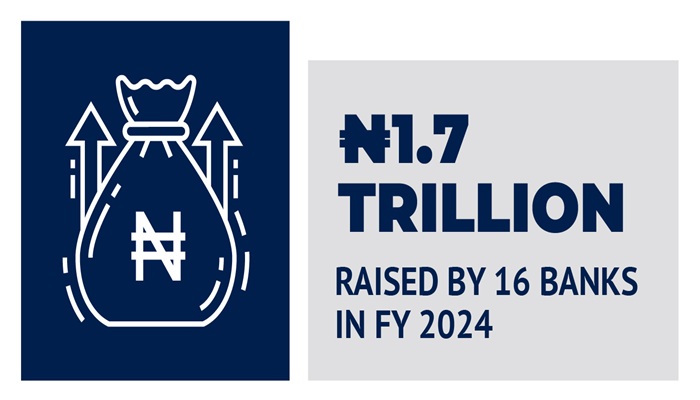Agusto & Co. Limited, the foremost business information provider and pan-African credit rating agency, has released its 2025 Nigerian Banking Industry Report.
The report provides a comprehensive review of Nigeria’s banking industry (“the industry”), detailing the industry’s structure, competitive environment, regulatory landscape, financial condition, trends, near-term expectations and outlook.
The Nigerian banking industry has remained resilient, successfully navigating various global and domestic macroeconomic vagaries.
The Industry has maintained an upward growth trajectory with total assets and contingents projected to reach N242.3 trillion ($151.4 billion @N1,600/$) by 31 December 2025 after expanding by 44.9% year-on-year to N186.6 trillion ($121.5 billion @N1,536/$) as at 31 December 2024.
Notwithstanding the funding pressure from the prevailing high-interest rate environment and the contractionary stance of the monetary authority, the industry remained liquid with a 59.4% (FYE 2023: 43.5%) liquidity ratio.
We believe the liquidity ratio will exceed 60% by FYE 2025, supported by favourable, albeit declining, yields on treasury securities. In our view, banks will accelerate the adoption of innovative funding strategies, as reflected in the uptick in commercial paper issuances, to moderate the impact of the funding pressures.

In the first seven months of 2025, commercial papers amounting to circa N750 billion were issued by various players. We anticipate more issuances particularly as the prevailing yields gradually moderate in the latter part of the year.
The introduction of the minimum paid-up capital in March 2024 drove recapitalisation activities in the Industry. Although the minimum paid-up capital directive will not be effective until 31 March 2026, about N1.7 trillion was raised by 16 banks in FY 2024.
Similarly, circa N800 billion was raised in the first seven months of 2025. Thus, eight banks have complied with the minimum paid-up capital directive as at 31 July 2025, ahead of the 31 March 2026 deadline. However, the mandatory verifications by the Central Bank of Nigeria (CBN) and the Securities and Exchange Commission (SEC) are pending on some of the capital raised.
We note positively that domestic investors provided most of the capital raised by the banks in the last 19 months, reflecting the acceptability of the Industry by Nigerians.

We anticipate the injection of an additional N900 billion as a significant number of banks strive to comply with the minimum capital directive before 31 December 2025. Thus, providing additional capital buffer for current business risks and near-term growth plans.
As at 31 December 2024, 5.2% of the industry loan book was adjudged as non-performing, higher than 4% recorded in the prior year, based on the deterioration of some credit facilities and the bloating impact of the 40.4%-naira depreciation during the year. We note that some non-performing loans benefitting from regulatory forbearance were included in the stage 2 category as of 31 December 2024. In June 2025, the CBN terminated the regulatory forbearance.
Thus, all loans are expected to be classified appropriately with the required provisions taken. All credit exposures are also expected to comply with the prescribed single obligor limit (SOL). In our view, the ongoing capital raising activities will resolve most of the SOL breaches on some exposures hitherto under forbearance. We also anticipate a surge in write-offs as some banks leverage the transition relief (waiver on the twelve months mandatory waiting period for duly provisioned impaired loans before write-offs) to address non-performing forbearance loans.
Notwithstanding, we believe the industry’s impaired loan ratio will surge to 6.9% as some non-performing forbearance loans are classified appropriately.
However, we expect a reduction in the impaired loan ratio before 31 December 2026 as the non-performing loans are resolved.
In the financial year ended 31 December 2024, the high-yield environment sustained the industry’s performance. The steep naira depreciation also supported profitability, albeit lower than the prior year, largely due to the zero net open position directive of the CBN. In FY 2025, we anticipate a decline in profitability indicators.
The need for the appropriate provision level on the hitherto forbearance loans will drive a surge in the impairment charge. The decision of some banks to accelerate the provision coverage and write off some impaired loans as part of the transitional reliefs will also contribute to higher impairment charges. In addition, we anticipate lower foreign currency revaluation gains that have bolstered profitability since FY 2023.
Overall, we expect a 19.2% decline in profit before taxation with the pre-tax return on average equity plummeting to 27.3% (FY 2024: 48.2%) in FY 2025.
However, the Industry’s profitability is expected to rebound in FY 2026 as the proceeds of the capital raising activities are fully deployed and the impact of the uptick in the impairment charge is moderated. Thus, we have attached a “stable” outlook to the Nigeria banking industry.

